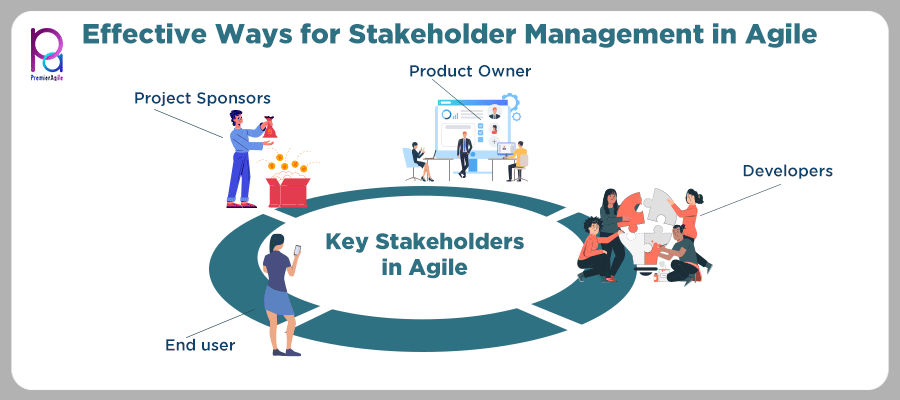Effective Ways for Stakeholder Management in Agile

Stakeholder management is a crucial aspect of most projects. It is generally overlooked or not provided enough attention. This happens both in Agile and predictive methodologies. As the project moves forward, the changing views of stakeholders are hard to incorporate. This can happen in predictive approaches. When it comes to Agile projects, responding to stakeholders when the project moves forward is at the very core. However, even in this approach, the incorporation is hard.
Who or What is a Stakeholder?
A stakeholder is an individual or an organization actively and effectively involved in a project. Also, the person or entity has interests that may negatively or positively affect the completion or performance of a project. A stakeholder may exert influence over the project, its deliverables or its project team members.
Stakeholder Management:
Stakeholder management in Agile is the art of understanding how to engage stakeholders. Here, stakeholders include executives, department heads and senior-level managers; internal and external partners. The engagement of these people is essential all through the project lifecycle for ensuring its success.
Management of stakeholders is important in Agile project management. The reason is that in an Agile setup, time is essential. It means that you will have to be mindful of safeguarding your team from potential distractions. At the same time, you will have to factor in the varying priorities and needs of your stakeholders.
Possible Barriers In the Way of Effective Stakeholder Management in Agile:
- In most instances, businesses can face trouble with keeping stakeholders engaged. This can happen particularly in large projects. The reason is that it can create a hefty layer of administration work. When they have other tasks in hand, they do not find time for the admin work.
- At times, some project owners feel differently even though they look for stakeholder engagement. They fear that constant stakeholder engagement in any project will generate more feedback. In turn, the team members cannot march forward with confidence to execute their ideas.
- Some stakeholders might have a specific vested interest in the success of a project. But, some just participate to share their comments.
- There can be hindrances concerning information access, transparency, and tooling. The reason is that some stakeholders wish that they should be kept informed. Particularly, they want in-person communication from one of the team members. This type of approach from anyone stakeholder can lead to missed chances for alignment.
What Will Happen If Stakeholders are not Engaged?
Of course, involving stakeholders in projects may cause the issues mentioned above. But, ensuring stakeholder engagement with proper stakeholder management is important. If your team does not involve stakeholders, you might not able to find:
- What is implemented by the team in reality?
- How much do the Developers understand?
- How do customers explain what they expect?
- What are the needs of customers?
When these things happen without stakeholder engagement, a lot of mistakes come up. If not checked for too long, the outcome will be costly rework. At times, it can even lead to project failure and loss of reputation. So, stakeholder management in Agile is important.
The Stakeholder Management Process Explained:
The process of managing these Stakeholders with proper communication, requirements and meeting the expectations of the project called the Stakeholder Management process and it encompasses the following steps:
- Identifying Stakeholders
- Analyzing Stakeholders
- Prioritizing Stakeholders
- Engaging Stakeholders
- Frequent Communication
1. Identifying Stakeholders:
You might have many stakeholders with a vested interest in your project or the entire organization. However, for your Agile stakeholder management, it is better to consider those with the ability to:
- Provide a voice of reason
- Facilitate the change that comes as the outcome of your project
- Lead opinions
- Remove impediments
- Slow down your project
- Enhance your project
- Impact your project
When you are in the process of identifying the right stakeholders, it is better not to forget external factors. These factors include regulatory agencies, competitors, supplies and subcontractors. Also, remember to shortlist stakeholders who can provide you with production support and IT Ops.
2. Analyzing Stakeholders:
Let us consider that you have completed the first step in Agile Stakeholder Management. The next thing you will have to do is to analyze stakeholders. When analyzing stakeholders, SAFe classified stakeholders into different categories. Let us throw some light on each of these categories below:
- Stakeholders with High Interest and High Influence:
The good thing about this category of stakeholders is that it is easy to identify them. This category encompasses business owners and others with considerable decision-making. It is easy to engage them. But, they can either nurture the project or can kill it. They can play a role in sustaining the project.
The best way to keep them engaged is to keep in touch with them regularly. Also, they should be kept updated about the project status.
- High Influence and Low Interest:
This category in Scrum stakeholder management encompasses stakeholders with considerable authority. It means that they are empowered to decide. But, as they have less interest, it is hard to engage them. Further, it is hard to keep in touch with them.
For the management of this category of stakeholders, you should do whatever you can to satisfy them.
- Low Influence and High Interest:
Stakeholders in this category may be impacted by the project. However, they do not have the power to make influential decisions. The problem with this category of stakeholders is that they may demand more of your time than your available time.
As they have a high level of interest, you should keep them informed on the project. You can keep in touch with them via publicity campaigns, presentations and email.
- Low Influence and Low Availability Stakeholders:
Stakeholders under this category are not involved. They may not even know about your project. Even, they might not be ready to see another email in their inbox from your end.
It is better to keep updated about them. Also, keep an eye on them to identify whether they are entering into other areas of your business.
3. Prioritize Stakeholders:
When prioritizing stakeholders, the popular technique you can follow is stakeholder mapping. It means that you should classify them based on their level of interest, impact and influence. Once you do this, you can develop the right strategies for engaging them. you can do this engagement based on the stakeholder mapping groups that you have created.
Building Strong Stakeholder Relationships
Effective stakeholder management in Agile is not just about communication. It's about building trust and fostering strong relationships. This involves understanding each stakeholder's concerns, motivations, and expectations. To achieve this:
- Listen actively: Stakeholders want to feel heard. Acknowledge their input and provide feedback, even if their ideas can't be implemented.
- Be transparent: Share challenges openly, not just successes. This transparency helps build credibility and trust.
- Show empathy: Understand stakeholder pressures and constraints. This empathy helps in creating solutions that work for both sides.
Balancing Stakeholder Needs with Team Focus
Agile teams thrive on focus and minimal interruptions. However, stakeholders often require updates or have new ideas that could change the project scope. Here’s how to balance this:
- Establish clear boundaries: Define communication channels and times for stakeholder interactions. This keeps interruptions minimal.
- Delegate communication roles: Designate a team member, like the Product Owner, to handle stakeholder communication so the rest of the team stays focused.
- Educate stakeholders: Help them understand Agile principles, including maintaining sprint integrity and minimizing scope changes.
Conflict Resolution in Stakeholder Management
Conflicts are inevitable, especially when dealing with multiple stakeholders with different priorities. Agile teams can resolve conflicts more effectively by:
- Identifying the root cause: Instead of addressing symptoms, focus on underlying issues to find long-term solutions.
- Facilitating open dialogues: Create safe spaces where stakeholders can voice concerns without judgment. This leads to more constructive conversations.
- Prioritizing project goals: Remind stakeholders of the project’s primary objectives to help them align their interests accordingly.
NPS stands for Net Promoter Score. It will help with gauging the loyalty of a stakeholder. Further, it is a very simple approach. It is the best alternative to traditional customer satisfaction surveys.
4. Engaging Stakeholders:
Stakeholder engagement is a crucial step in stakeholder management in Agile. At this point, you have already identified and prioritized the stakeholders. Now, it is time to define how you will be interacting with them. It can happen through workshops, SAFe program events or Scrum ceremonies, standing meetings or one-on-one conversations. At this stage, the frequency should be set. Also, the objectives of the meetings should be identified.
Other methods to engage stakeholders:
You can also follow any of the following techniques to engage stakeholders:
- Through use case modeling
- User experience mock-ups
- Questionnaires
- Customer Interviews
- Brainstorming sessions
- Requirement workshops
Addressing Stakeholder Resistance
Resistance to Agile practices is common, especially from stakeholders accustomed to predictive methodologies. Here’s how to handle it:
- Educate and align: Conduct workshops to help stakeholders understand Agile's benefits and how it can address their concerns.
- Involve them in Agile ceremonies: This firsthand experience demystifies Agile practices and fosters acceptance.
- Showcase quick wins: Delivering valuable increments quickly helps gain stakeholder confidence and reduce resistance.
Managing Remote Stakeholders
With remote work becoming more common, Agile teams must adapt their stakeholder management strategies:
- Leverage digital tools: Use collaboration platforms like Slack, Microsoft Teams, and virtual whiteboards for seamless communication.
- Maintain regular touchpoints: Schedule frequent virtual check-ins to keep stakeholders informed and engaged.
- Document and share transparently: Record meetings or share detailed notes to keep everyone on the same page, regardless of time zones.
5. Frequent Communication:
Here, frequent communication is essential. The reason is that the stakeholders have rights. But, they have responsibilities as well. They have the right to have an engaged team. They have the right to be informed of the progress of the team. Their responsibility is to stay engaged from the beginning to the completion of the project. They are responsible for providing support and feedback regularly. They are also responsible for contributing to the growth of a dependable Agile atmosphere.
The Role of the Product Owner in Stakeholder Management
The Product Owner (PO) plays a pivotal role in Agile stakeholder management:
- Central communication hub: The PO gathers stakeholder inputs and translates them into actionable user stories, reducing noise for the development team.
- Prioritization and negotiation: The PO balances conflicting stakeholder priorities, ensuring the highest value items are worked on first.
- Expectation management: The PO manages stakeholder expectations by providing realistic timelines and deliverables, minimizing conflicts.
Managing Expectations:
To manage the expectations of stakeholders, one thing you can do is to explain to them that you are making progress. You should let them know that you are moving towards the overall outcome. You can do this by communicating with them at regular intervals. It is better to ensure that you provide stakeholders with updates anywhere between a couple of weeks and a couple of months once.
References:
- https://www.scrum.org/resources/blog/effective-stakeholder-management
- https://blog.zenhub.com/stakeholder-management-agile-software-development/
- https://www.berg-software.com/en/insights/agile-stakeholder-engagement/




